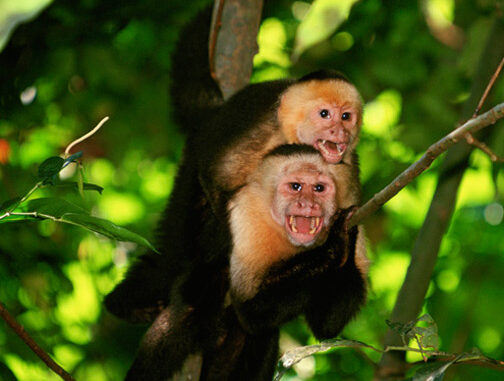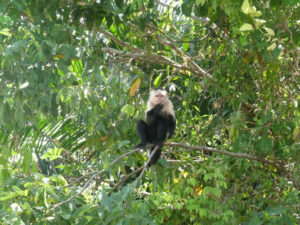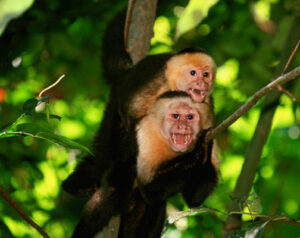
If you would enjoy being entertained by monkeys “monkeying around” in the trees, then hop on a plane to Costa Rica! Four types of monkeys inhabit the Costa Rican forests—capuchin monkeys, howler monkeys, spider monkeys, and squirrel monkeys. All have strong prehensile tails that they use to grasp, hang, and swing from branches. Diet can vary from species to species, but in general they eat mostly fruits. They also eat leaves, flowers, nuts, seeds, bark, twigs, and, on occasion, insects, small birds, bird eggs, lizards, and small mammals such as baby squirrels and coatimundis. They live in groups of varying sizes and spend most of their time up in trees. Their only major predators are jaguars, snakes, humans, and large birds such as eagles.

Lissa Harrison
Capuchin monkey, Manuel Antonio National Park
Capuchin monkeys are named after the Capuchin Friars, because the monkeys’ white neck and head with black cap resembles the hoods worn by Franciscan Capuchin monks. These agile, intelligent, inquisitive monkeys actively search for food during the day. They tear off bark to look for insects, they steal bird eggs, and the ones who live near a coast even catch oysters and mollusks, which they break on rocks to open. These bold monkeys have even been known to raid farmers’ crops for corn! They are often seen in the trees swinging from branch to branch in single file until rest time, when they nap or groom one another for fleas and ticks. They communicate with dramatic facial expressions, vocalizations, and gestures, such as jumping up and down, banging objects, and throwing sticks to assert their authority. If you’ve ever seen an organ grinder with a dancing monkey, it was most likely a capuchin!
Howler monkeys are the largest and loudest of the Costa Rican monkeys. In fact, they are considered to be the loudest land animal on Earth. Their booming cries, most often at dawn and dusk, consist of short, loud barks along with extended deep growls. These noisy jam sessions can be heard up to 3 miles away. Although their explosive roars sound aggressive and frightening, these monkeys are actually very peaceful and like nothing more than moving slowly through the trees munching leaves, their favorite food. They are the least active of all the Costa Rican monkeys. If you want to hear what they sound like, you can go to the Internet and listen to many entertaining videos.

Philip Coblentz/SuperStock
Two capuchin monkeys
Spider monkeys are so named because they have long, skinny limbs and a long, strong, skinny tail that is longer than their body. The underside of this extraordinary tail is textured, making it easy to hang and swing from branches, collect water, and pick fruit. Extremely quick and flexible, they are the most agile Costa Rican monkey and enjoy leaping from tree to tree. Did you used to play on the “monkey bars” as a child? If so, you were imitating this acrobatic monkey’s hand-over-hand motion of swinging through the trees. They are very social creatures and communicate with body gestures, chatter, screeches, barks, and whines.

Dave Moyer
A squirrel monkey eating in a tree
Squirrel monkeys are the smallest of the Costa Rican monkeys, measuring about one foot, not counting the tail, and weighing one to three pounds. They are extremely hyperactive—always on the go, day and night. They tend to travel in large groups through the trees of the forest foraging for insects, which make up about 75 percent of their diet. They are an endangered species in Costa Rica and are found only in the rain forests of the southern Pacific area of the country, such as in Manuel Antonio National Park and on the Osa Peninsula. The Costa Rican Ministry for the Interior and the National Zoo are raising money to help the survival of this cute little monkey.